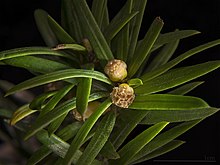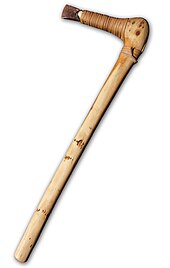Taxus
[1] Yews occur around the globe in temperate zones of the northern hemisphere, northernmost in Norway and southernmost in the South Celebes.
[5][6] The seed cones are highly modified, each cone containing a single seed 4–7 mm (5⁄32–9⁄32 in) long partly surrounded by a modified scale which develops into a soft, bright red berry-like structure called an aril, 8–15 mm (5⁄16–19⁄32 in) long and wide and open at the end.
[2] The most distinct is the Sumatran yew (T. sumatrana, native to Sumatra and Celebes north to southernmost China), distinguished by its sparse, sickle-shaped yellow-green leaves.
[citation needed] Yews typically occur in the understory or canopy of moist temperate or tropical mountain forests.
[2] Yews are common in landscape architecture, giving rise to widespread naturalized populations in the United States.
Austrotaxus Pseudotaxus T. brevifolia T. globosa T. floridana T. canadensis T. cuspidata T. contorta T. baccata T. wallichiana T. Huangshan type T. chinensis T. phytonii T. calcicola T. mairei T. brevifolia T. floridana T. globosa T. wallichiana T. chinensis T. florinii T. calcicola T. phytonii T. sumatrana T. canadensis T. cuspidata T. baccata T. mairei T. contorta T. fuana All species of yew contain highly poisonous taxine alkaloids, with some variation in the exact formula of the alkaloid between the species.
[22] Yews in this genus are primarily separate-sexed, and males are extremely allergenic, with an OPALS allergy scale rating of 10 out of 10.
Ötzi, the Chalcolithic mummy found in 1991 in the Italian Alps, carried an unfinished bow made of yew wood.
Consequently, it is not surprising that in Norse mythology, the abode of the god of the bow, Ullr, had the name Ydalir (Yew Dales).
[23] The yew longbow was the critical weapon used by the English in the defeat of the French cavalry at the Battle of Agincourt, 1415.
British yews tend to be too gnarly, and thus the wood for English longbows used at the Battle of Agincourt was imported from Spain or northern Italy.
[24] It is suggested that English parishes were required to grow yews and, because of the trees' toxic properties, they were grown in the only commonly enclosed area of a village – the churchyard.
Those can be sustainably harvested without the need to further endanger wild populations, and the Pacific yew is no longer at risk.
[31] The more common Canada yew is also being successfully harvested in northern Ontario, Quebec and New Brunswick, and has become another major source of paclitaxel.







